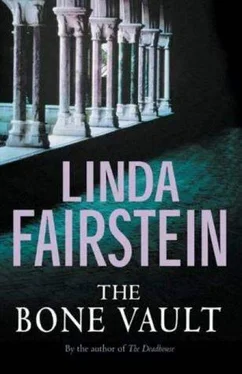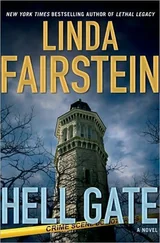“Did Ms. Grooten have access to the room?”
Bellinger paused for a moment. “Certainly. But she wasn’t in the habit of licking paintbrushes, Mr. Chapman.” He was beginning to snap at Mike.
“And Napoléon didn’t chew on his wallpaper, either.”
“What?” the puzzled curator asked.
“There was arsenic found in locks of Napoléon’s hair. Lots of it. There were theories that his captors did him in, and some wild conjecture that he was poisoned by the vapors from the wallpaper color in his room at St. Helena’s, during his exile. Copper arsenite.”
“Scheele’s green, probably. A brilliant pigment. We’ve got some of that, too. Don’t use as much of it because it wasn’t created until after the Renaissance, so it wouldn’t be authentic to our pieces.”
“That’s exactly why we need to know what Grooten was working on and who she dealt with,” I said. Mike knew more about the great Corsican general than Pat McKinney knew about the law. If he got off on a Napoléonic tangent, we’d be here until midnight. “I assume you have a way to tell us whether any tubes or vials are missing?”
“I’m sure I don’t. The workmen get all the supplies they need by ordering from the Met. Ask Pierre Thibodaux. Ask Erik Poste. Ask the other medievalists.”
His counterparts at the main branch were obvious interview subjects. “Why Thibodaux? Why Poste?”
“I’m sure the director’s office has all the billing records for the goods that are purchased for our needs. The ever-rigid Ms. Drexler must be able to put her fingers on that. There are a host of toxic substances in paints and pigments, varnishes and cleaning agents. And we’re not the only ones who restore old artworks, Ms. Cooper. Mr. Poste’s European collection has far more extensive restoration projects than do I.”
I didn’t think he was pointing the finger at other colleagues as much as he was highlighting how frustrating our search would be in an institution that apparently needed poisons to enliven the glorious holdings the public came to view.
“May we have this copy of Ms. Grooten’s personnel file to take with us?” I asked.
“I’ve reproduced the entire thing for you.”
I opened it from the back and saw the letter of resignation first. It had been written on a word processor and dated December 24 of the previous year. In place of a signature was the capital letterK, drawn with a marker in almost a stick-figure print.
“Is that how she usually signed things, not spelling out her whole name?”
Bellinger took the document from my hand. “Straight and simple, just like that. She usually used both initials, but herG was more Gothic, if you will.” He closed his eyes as if to call up an image of her signature. “TheG would have been harder to imitate, come to think of it, if someone else did the writing.”
I hadn’t suggested that the letter wasn’t written by Grooten. “Why would you think she didn’t write this herself?”
“I-uh, I don’t know. When did she die? I just mean she never came back to work after the twentieth, if I’m not wrong. Maybe she’d already been murdered, and the killer wrote this so I wouldn’t be worried about her disappearance.”
“And were you?”
“I was out of town that entire period, visiting my in-laws for the holidays. I never knew Katrina had quit until I returned in January. She was gone, and I thought she had left the country. There wasn’t much I could do about it until she sent me a forwarding address, as that letter said she would do once she got set up at home.”
“Did she have a computer when she was working here?”
“Yes, of course.”
“With an e-mail address?” I could see where Mike was going.
“So far as I know, the only e-mail address Katrina had was through the museum system. You’ll see in her file some correspondence that arrived for her after she left for South-” He caught himself. “After she resigned. We bought an entire new computer system, hardware and software, which was installed after the first of the year.
“When they dismantled Katrina’s equipment, I authorized the head of our management information systems to go into her account with her password, to make sure that nothing had come in for her that was related to museum business.”
“Did they find anything?”
“Minor correspondence, really. There were a few responses to requests for materials from museums overseas. We’ve got a good number of objects out on loan that she wanted to see photographs of, for their possible inclusion in the bestiary show. I forwarded those to the committee she had been working with. Gaylord, Friedrichs, Poste, and the others.”
“Anything personal?”
“Those should be in that packet you’re holding. A bunch of Christmas and New Year’s greetings from people she knew, here and abroad.”
I opened the file from the front this time, to skim through it to find those letters. I was arrested by the photograph of the young woman that appeared on the museum identification tag dated almost three years ago. The contrast to the Polaroid that had been taken the night we found the body was stunning. Grooten had smiled at the camera when she first came to work here, her face fuller and her light brown hair alive with chestnut streaks, as bouncy as a commercial for a home permanent.
I twisted the folder and showed the shot to Mercer, who shook his head.
“Something wrong?” Bellinger asked.
“I hadn’t seen her before, except the photographs made the night before last. I realize this was taken a few years ago, but is it a pretty good likeness?”
Bellinger reached across and looked at Grooten. “A very good one. Until last fall. That’s when she began losing weight and developed that awful pallor.”
Mike pulled the more recent picture from his jacket pocket.
Bellinger looked at it and again closed his eyes. “It’s not the way I like to think of her, but it’s certainly how she began to look by October.”
Perhaps Thibodaux hadn’t been lying to us. It was hard to imagine the physical transformation this young woman had undergone in the short months before her death.
“How about her apartment?” Mercer asked. “Did you ever check there to see what happened to her belongings?”
“My wife and I went to see the super in-let me think-it must have been the middle of January. When she was ten days late with that month’s rent, he called the museum. No one in his small building had seen her in weeks, and my secretary said she had resigned to leave the country. He cleaned out the apartment and rented it again before-”
Mike interrupted. “How about her things? Her belongings?”
“Katrina hadn’t accumulated much stuff. He figured she just bolted on her last month’s rent. She left no forwarding information, so the super held a tag sale in the building to get rid of what he could, and threw everything else out on the sidewalk.”
Mike was thinking about potential evidence. I imagined the possessions of the young woman’s life, meager as they were. Family photographs, treasured art books, perhaps an heirloom-a ring or bracelet that had belonged to an ancestor or friend. All discarded or sold for a few weeks of back rent in a cheap tenement building by a landlord who didn’t think to question her disappearance.
“This work that Katrina did, with medieval tombs and their sculpture, what was it exactly?” Mike asked. “Did shewant to do that, or did you assign it to her?”
“It was the specialty she chose, Detective.”
“Grim, wouldn’t you say?”
“Not as grim as your job, Mr. Chapman. That’s what most people in my line of work would think. Would you like to see what she was doing here? I can show you on our way out.”
Читать дальше












